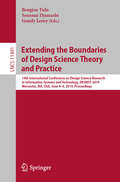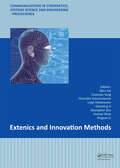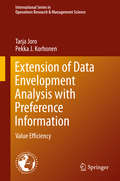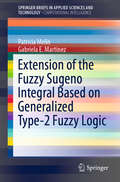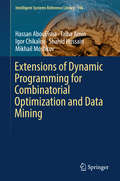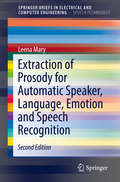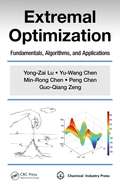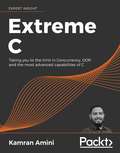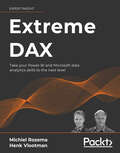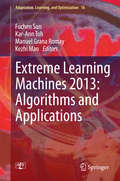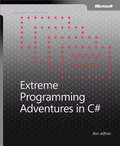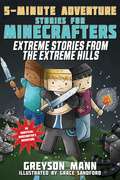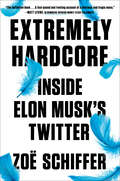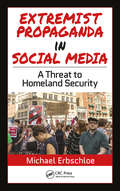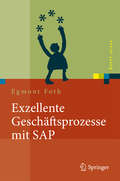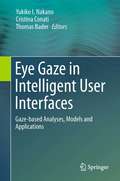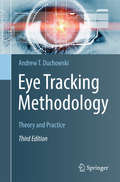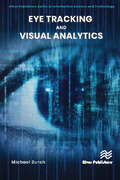- Table View
- List View
Extending the Boundaries of Design Science Theory and Practice: 14th International Conference on Design Science Research in Information Systems and Technology, DESRIST 2019, Worcester, MA, USA, June 4–6, 2019, Proceedings (Lecture Notes in Computer Science #11491)
by Gondy Leroy Bengisu Tulu Soussan DjamasbiThis book constitutes the thoroughly refereed proceedings of the 14th International Conference on Designing for a Digital and Globalized World, DESRIST 2019, held Worcester, MA, USA, June 2019. The 20 revised full papers included in the volume were carefully reviewed and selected from 54 submissions. They are organized in the following topical sections: Design Science Research Theory and Methodology; Design Science Research Applications in Healthcare; Design Science Research Applications in Data Science; and Design Science Research Applications in Emerging Topics.
Extenics and Innovation Methods (Communications in Cybernetics, Systems Science and Engineering – Proceedings)
by Florentin Smarandache Wen Cai & Chunyan Yang Luigi Vladareanu Qiaoxing Li Guangtian Zou Yanwei ZhaoSociety forges ahead in the process of solving various contradictory problems and it is ceaselessly innovating. It is the desire of mankind to use computers and computing networks to help deal with contradictory problems and to conduct innovative activities. Using formal models to discuss object extension and the possibility of change, as well as t
Extension of Data Envelopment Analysis with Preference Information
by Tarja Joro Pekka J. KorhonenThis book provides an introduction to incorporating preference information in Data Envelopment Analysis (DEA) with a special emphasis in Value Efficiency Analysis. In addition to theoretical considerations, numerous illustrative examples are included. Hence, the book can be used as a teaching text as well. Only a modest mathematical background is needed to understand the main principles. The only prerequisites are a) familiarity with linear algebra, especially matrix calculus; b) knowledge of the simplex method; and c) familiarity with the use of computer software. The book is organized as follows. Chapter 1 provides motivation and introduces the basic concepts. Chapter 2 provides the basic ideas and models of Data Envelopment Analysis. The efficient frontier and production possibility set concepts play an important role in all considerations. That's why these concepts are considered more closely in Chapter 3. Since the approaches introduced in this study are inspired by Multiple Objective Linear Programming, the basic concepts of this field are reviewed in Chapter 4. Chapter 5 also compares and contrasts Data Envelopment Analysis and Multiple Objective Linear Programming, providing some cornerstones for approaches presented later in the book. Chapter 6 discusses the traditional approaches to take into account preference information in DEA. In Chapter 7, Value Efficiency is introduced, and Chapter 8 discusses practical aspects. Some extensions are presented in Chapter 9, and in Chapter 10 Value Efficiency is extended to cover the case when a production possibility set is not convex. Three implemented applications are reviewed in Chapter 11.
Extension of the Fuzzy Sugeno Integral Based on Generalized Type-2 Fuzzy Logic (SpringerBriefs in Applied Sciences and Technology)
by Patricia Melin Gabriela E. MartinezThis book presents an extension of the aggregation operator of the generalized interval type-2 Sugeno integral using generalized type-2 fuzzy logic. This extension enables it to handle higher levels of uncertainty when adding any number of sources and types of information in a wide variety of decision-making applications. The authors also demonstrate that the extended aggregation operator offers better performance than other traditional or extended operators. The book is a valuables reference resource for students and researchers working on theory and applications of fuzzy logic in various areas of application where decision making is performed under high levels of uncertainty, such as pattern recognition, time series prediction, intelligent control and manufacturing.
Extensions of Dynamic Programming for Combinatorial Optimization and Data Mining (Intelligent Systems Reference Library #146)
by Hassan AbouEisha Talha Amin Igor Chikalov Shahid Hussain Mikhail MoshkovDynamic programming is an efficient technique for solving optimization problems. It is based on breaking the initial problem down into simpler ones and solving these sub-problems, beginning with the simplest ones. A conventional dynamic programming algorithm returns an optimal object from a given set of objects. This book develops extensions of dynamic programming, enabling us to (i) describe the set of objects under consideration; (ii) perform a multi-stage optimization of objects relative to different criteria; (iii) count the number of optimal objects; (iv) find the set of Pareto optimal points for bi-criteria optimization problems; and (v) to study relationships between two criteria. It considers various applications, including optimization of decision trees and decision rule systems as algorithms for problem solving, as ways for knowledge representation, and as classifiers; optimization of element partition trees for rectangular meshes, which are used in finite element methods for solving PDEs; and multi-stage optimization for such classic combinatorial optimization problems as matrix chain multiplication, binary search trees, global sequence alignment, and shortest paths. The results presented are useful for researchers in combinatorial optimization, data mining, knowledge discovery, machine learning, and finite element methods, especially those working in rough set theory, test theory, logical analysis of data, and PDE solvers. This book can be used as the basis for graduate courses.
Extraction and Representation of Prosody for Speaker, Speech and Language Recognition
by Leena MaryExtraction and Representation of Prosodic Features for Speech Processing Applications deals with prosody from speech processing point of view with topics including: The significance of prosody for speech processing applicationsWhy prosody need to be incorporated in speech processing applicationsDifferent methods for extraction and representation of prosody for applications such as speech synthesis, speaker recognition, language recognition and speech recognitionThis book is for researchers and students at the graduate level.
Extraction of Prosody for Automatic Speaker, Language, Emotion and Speech Recognition (SpringerBriefs in Speech Technology)
by Leena MaryThis updated book expands upon prosody for recognition applications of speech processing. It includes importance of prosody for speech processing applications; builds on why prosody needs to be incorporated in speech processing applications; and presents methods for extraction and representation of prosody for applications such as speaker recognition, language recognition and speech recognition. The updated book also includes information on the significance of prosody for emotion recognition and various prosody-based approaches for automatic emotion recognition from speech.
Extraterrestrische Maschinen: Auf der Suche nach außerirdischer Intelligenz
by Wilfried DomainkoIn diesem Buch wird die Suche nach extraterrestrischen Strukturen diskutiert, die möglicherweise künstlichen Ursprungs sind. Die Fahndung nach künstlichen, extraterrestrischen Objekten wird jedoch durch die extrem vielfältigen Erscheinungsformen von natürlichen Himmelkörpern erschwert. Trotzdem ist die gezielte Suche nach außerirdischen Maschinen von riesigen Ausmaßen eine Möglichkeit, extraterrestrische Intelligenz zu entdecken. Tatsächlich besteht die Möglichkeit, einige Beobachtungen von außergewöhnlichen Himmelsobjekten entweder im Zusammenhang mit exotischen natürlichen Phänomenen oder aber als solche Technologiesignaturen zu deuten. Extraterrestrische Maschinen könnten technologisch viel fortschrittlicher sein als ihre irdischen Gegenstücke. Im Rahmen des zweiten Erklärungsansatzes könnten modifizierte Sterne als stellare Maschinen dienen, ganze Planeten nach den Bedürfnissen ihrer Bewohner umgestaltet werden oder gigantische Megastrukturen ihre Heimatsterne verdunkeln. Auch in unserem Sonnensystem wären Signaturen von extraterrestrischen Maschinen denkbar. Entsprechend könnten Beobachtungen von einigen sich bewegenden Himmelsobjekten mitunter im Zusammenhang mit interstellaren Raumsonden oder extraterrestrischem Weltraumschrott interpretiert werden. Neben der Vorstellung von möglichen beobachteten Technologiesignaturen und deren natürlichen und künstlichen Erklärungsmodellen, werden in diesem Buch auch verwandte irdische Technikvorhaben mit den entsprechenden Beobachtungen verglichen. In diesem Zusammenhang könnte das Auffinden von extraterrestrischen Maschinen sogar die menschliche Technologieentwicklung verändern.
Extremal Optimization: Fundamentals, Algorithms, and Applications
by Yong-Zai Lu Yu-Wang Chen Min-Rong Chen Peng Chen Guo-Qiang ZengExtremal Optimization: Fundamentals, Algorithms, and Applications introduces state-of-the-art extremal optimization (EO) and modified EO (MEO) solutions from fundamentals, methodologies, and algorithms to applications based on numerous classic publications and the authors’ recent original research results. It promotes the movement of EO from academic study to practical applications. The book covers four aspects, beginning with a general review of real-world optimization problems and popular solutions with a focus on computational complexity, such as "NP-hard" and the "phase transitions" occurring on the search landscape. Next, it introduces computational extremal dynamics and its applications in EO from principles, mechanisms, and algorithms to the experiments on some benchmark problems such as TSP, spin glass, Max-SAT (maximum satisfiability), and graph partition. It then presents studies on the fundamental features of search dynamics and mechanisms in EO with a focus on self-organized optimization, evolutionary probability distribution, and structure features (e.g., backbones), which are based on the authors’ recent research results. Finally, it discusses applications of EO and MEO in multiobjective optimization, systems modeling, intelligent control, and production scheduling. The authors present the advanced features of EO in solving NP-hard problems through problem formulation, algorithms, and simulation studies on popular benchmarks and industrial applications. They also focus on the development of MEO and its applications. This book can be used as a reference for graduate students, research developers, and practical engineers who work on developing optimization solutions for those complex systems with hardness that cannot be solved with mathematical optimization or other computational intelligence, such as evolutionary computations.
Extreme C
by Kamran AminiExtreme C is for C programmers who want to dig deep into the language and its capabilities. It will help you make the most of the low-level control C gives you
Extreme DAX: Take your Power BI and Microsoft data analytics skills to the next level
by Michiel Rozema Henk VlootmanDiscover the true power of DAX and build advanced DAX solutions for practical business scenariosKey FeaturesSolve complex business problems within Microsoft BI tools including Power BI, SQL Server, and ExcelDevelop a conceptual understanding of critical business data modeling principlesLearn the subtleties of Power BI data visualizations, evaluation context, context transition, and filteringBook DescriptionIf you want to get the most out of Microsoft Business Intelligence tools, sooner or later you'll need to master DAX. Extreme DAX enables business analysts to generate powerful and sophisticated analyses from their data.You'll learn the principles of business intelligence, good model design, and how DAX fits into it all. Then, you'll launch into detailed examples of DAX in real-world business scenarios such as inventory calculations, forecasting, intercompany business, and data security. At each step, senior DAX experts will walk you through the subtleties involved in working with Power BI models and common mistakes to look out for as you build advanced data aggregations.You'll deepen your understanding of DAX functions, filters, and measures, and how and when they can be used to derive effective insights. Also provided with the book are PBIX files for each chapter for you to follow along with and explore in your own time.What you will learnUnderstand data modeling concepts and structures before you start working with DAXGrasp how relationships in Power BI models are different from those in RDBMSesSecure aggregation levels, attributes, and hierarchies using PATH functions and row-level securityGet to grips with the crucial concept of contextApply advanced context and filtering functions including TREATAS, GENERATE, and SUMMARIZEExplore dynamically changing visualizations with helper tables and dynamic labels and axesWork with week-based calendars and understand standard time-intelligenceEvaluate investments intelligently with the XNPV and XIRR financial DAX functionsWho this book is forIf you are an analyst with a working knowledge of DAX in MS Power BI or other Microsoft analytics tools, this book will help you upgrade your DAX knowledge and work with analytical models more effectively.This book is not for beginners and practical experience with DAX is necessary.
Extreme Events and Natural Hazards
by Vijay P. Dimri Daniel N. Baker A. Surjalal Sharma Armin BundePublished by the American Geophysical Union as part of the Geophysical Monograph Series, Volume 196.Extreme Events and Natural Hazards: The Complexity Perspective examines recent developments in complexity science that provide a new approach to understanding extreme events. This understanding is critical to the development of strategies for the prediction of natural hazards and mitigation of their adverse consequences. The volume is a comprehensive collection of current developments in the understanding of extreme events. The following critical areas are highlighted: understanding extreme events, natural hazard prediction and development of mitigation strategies, recent developments in complexity science, global change and how it relates to extreme events, and policy sciences and perspective. With its overarching theme, Extreme Events and Natural Hazards will be of interest and relevance to scientists interested in nonlinear geophysics, natural hazards, atmospheric science, hydrology, oceanography, tectonics, and space weather.
Extreme Learning Machines 2013: Algorithms and Applications
by Fuchen Sun Kar-Ann Toh Manuel Grana Romay Kezhi MaoIn recent years, ELM has emerged as a revolutionary technique of computational intelligence, and has attracted considerable attentions. An extreme learning machine (ELM) is a single layer feed-forward neural network alike learning system, whose connections from the input layer to the hidden layer are randomly generated, while the connections from the hidden layer to the output layer are learned through linear learning methods. The outstanding merits of extreme learning machine (ELM) are its fast learning speed, trivial human intervene and high scalability. This book contains some selected papers from the International Conference on Extreme Learning Machine 2013, which was held in Beijing China, October 15-17, 2013. This conference aims to bring together the researchers and practitioners of extreme learning machine from a variety of fields including artificial intelligence, biomedical engineering and bioinformatics, system modelling and control, and signal and image processing, to promote research and discussions of "learning without iterative tuning". This book covers algorithms and applications of ELM. It gives readers a glance of the newest developments of ELM.
Extreme Privacy: What It Takes to Disappear
by Michael BazzellMichael Bazzell has helped hundreds of celebrities, billionaires, and everyday citizens completely disappear from public view. He is now known in Hollywood as the guy that “fixes” things. His previous books about privacy were mostly REACTIVE and he focused on ways to hide information, clean up an online presence, and sanitize public records to avoid unwanted exposure. <p><p>This textbook is PROACTIVE. It is about starting over. It is the complete guide that he would give to any new client in an extreme situation. It leaves nothing out, and provides explicit details of every step he takes to make someone completely disappear, including document templates and a chronological order of events. The information shared in this volume is based on real experiences with his actual clients, and is unlike any content ever released in his other books.
Extreme Programming Adventures in C#
by Ron JeffriesSee eXtreme Programming (XP) in action at the hands of an XP master--and learn Microsoft .NET and C# programming in the process! In this fast-paced, hands-on exposition, Ron Jeffries--one of the leading voices and practitioners in the XP community--demonstrates that you can write well-designed, resilient code incrementally and safely, while minimizing your investment in speculative up-front design. As Jeffries builds his sample application, you get firsthand insights into what successful XP development looks like, complete with real-world challenges such as the eleventh-hour change order. For further practice and study, you can download all the author's code--including the missteps--so you can see XP and agile concepts in action and assess how they fit into your own work. Pair program with an XP master, discovering how to: Streamline and simplify the software development process Work more effectively as part of an XP development team Reduce missteps by designing, testing, and refining code in increments Receive clearer specifications and feedback from customers Write cleaner, more expressive code--and weed out more bugs Conserve resources by planning and reassessing progress as you go Maintain a sustainable work pace--and avoid burnout Step up delivery dates, shipping the most crucial features first Improve customer satisfaction!
Extreme Programming Adventures in C#
by Ronald JeffriesApply what you know about extreme programming and object- oriented design to learning C# and the Microsoft .NET Framework on the fly. Author Ron Jeffries, a leading voice and practitioner in the extreme programming movement, demonstrates how to apply its key concepts-including the use of customer stories, customer acceptance tests, and "Spikes"-and the fundamental techniques of Simple Design, Test-Driven Development, and Refactoring to create practical, NET-ready applications. You'll also learn how to use NUnit, a unit-testing tool for .NET languages. This essential, high-level reference provides the expert guidance, hands-on insights, and downloadable code you need to build an XML editor, a database application, a Web service, and other useful applications.
Extreme Programming Pocket Guide
by Chromatic<p>The <i>Extreme Programming Pocket Guide</i> covers XP assumptions, principles, events, artifacts, roles, and resources, and more. It concisely explains the relationships between the XP practices. If you want to adopt XP in stages, the <i>Extreme Programming Pocket Guide</i> will help you choose what to apply and when. Concise and easy to use, this handy pocket guide to XP is a must-have quick reference for anyone implementing a test-driven development environment. </p>
Extreme Programming Pocket Guide: Team-Based Software Development
by ChromaticExtreme Programming (XP) is a radical new approach to software development that has been accepted quickly because its core practices--the need for constant testing, programming in pairs, inviting customer input, and the communal ownership of code--resonate with developers everywhere. Although many developers feel that XP is rooted in commonsense, its vastly different approach can bring challenges, frustrations, and constant demands on your patience.Unless you've got unlimited time (and who does these days?), you can't always stop to thumb through hundreds of pages to find the piece of information you need. The Extreme Programming Pocket Guide is the answer. Concise and easy to use, this handy pocket guide to XP is a must-have quick reference for anyone implementing a test-driven development environment.The Extreme Programming Pocket Guide covers XP assumptions, principles, events, artifacts, roles, and resources, and more. It concisely explains the relationships between the XP practices. If you want to adopt XP in stages, the Extreme Programming Pocket Guide will help you choose what to apply and when. You'll be surprised at how much practical information is crammed into this slim volume.O'Reilly's Pocket Guides have become a favorite among developers everywhere. By providing a wealth of important details in a concise, well-organized format, these handy books deliver just what you need to complete the task at hand. When you've reached a sticking point in your work and need to get to a solution quickly, the new Extreme Programming Pocket Guide is the book you'll want to have beside your keyboard.
Extreme Stories from the Extreme Hills: 5-Minute Adventure Stories for Minecrafters (5-Minute Stories for Minecrafters #1)
by Grace Sandford Greyson MannWhile Audrey yearns for new adventures, her brother Oliver dreams of hidden treasures. When the twins explore different biomes, they find plenty of both in 5-Minute Adventures for Minecrafters, an all-new series of stories for Minecrafters that can be read in 5 minutes! In Extreme Stories from the Extreme Hills, Audrey and Oliver collect many treasures—and mini adventures. For every dangerous hike up a rocky cliff, there’s a waterfall roaring back down. Each dungeon hides a treasure chest—but also a monster spawner! As the mobs get deadlier, the stakes grow higher. The twins hope to make it back to Birchtown with their treasures in hand. Will the next ravine lead to riches or to a river of hot lava? There’s only one way to find out. These five-minute stories promise plenty of twists and turns—and surprise endings. In 5-Minute Adventures for Minecrafters: Extreme Stories from the Extreme Hills, the twins explore one of the Overworld’s most treacherous terrains, one exciting step at a time.
Extremely Hardcore: Inside Elon Musk's Twitter
by Zoë Schiffer"Zoë Schiffer has written the definitive book on perhaps the weirdest business story of our time. A fast-paced and riveting account of a hilarious and tragic mess."— Matt Levine, Bloomberg Opinion &“Money Stuff&” columnist&“the bird is freed&”- Elon Musk (@elonmusk) October 27, 2022When Elon Musk took over Twitter, commentators were rooting for the visionary behind Tesla and SpaceX to succeed. Here was a tough leader who could grab back power from Twitter&’s entitled workforce, motivate them to get &“extremely hardcore,&” and supercharge Twitter&’s profit and potential. And it was all out of the goodness of his own heart, rooted in his fervent belief in the necessity of making Twitter friendlier to free speech. "I didn&’t do it to make more money,&” Musk said. &“I did it to try and help humanity, whom I love.&” Once Musk charged into the Twitter headquarters, the command-and-control playbook Musk honed at Tesla and SpaceX went off the rails immediately. Distilling hundreds of hours of interviews with more than sixty employees, thousands of pages of internal documents, Slack messages, presentations, as well as court filings and congressional testimony, Extremely Hardcore is the true story of how Musk reshaped the world&’s online public square into his own personal megaphone. You&’ll hear from employees who witnessed the destruction of their workplace in real-time, seeing years of progress to fight disinformation and hate speech wiped out within a matter of months. There&’s the machine-learning savant who went all-in on Twitter 2.0 before getting betrayed by his new CEO, the father whose need for healthcare swept him into Musk&’s inner circle, the trust and safety expert who became the subject of a harassment campaign his former boss incited, and the many other employees who tried to save the company from their new boss&’s worst instincts. This is the story of Twitter, but it&’s also a chronicle of the post-pandemic labor movement, a war between executives and a workforce newly awakened to their rights and needs. Riveting, character-driven, and filled with jaw-dropping revelations, Extremely Hardcore is the definitive, fly-on-the-wall story of how Elon Musk lit $44 billion on fire and burned down Twitter. It&’s the next best thing to being there, and you won&’t have to sleep in the Twitter office to get the scoop.
Extremist Propaganda in Social Media: A Threat to Homeland Security
by Michael ErbschloeExtremist Propaganda in Social Media: A Threat to Homeland Security presents both an analysis of the impact of propaganda in social media and the rise of extremism in mass society from technological and social perspectives. The book identifies the current phenomenon, what shall be dubbed for purposes of this book "Blisstopian Societies"—characterized in the abiding "ignorance is bliss" principle—whereby a population is complacent and has unquestioning acceptance of a social doctrine without challenge and introspection. In these subcultures, the malleable population self-select social media content, "news," and propaganda delivery mechanisms. By doing so, they expose themselves only to content that motivates, reinforces, and contributes to their isolation, alienation, and self-regulation of the social groups and individuals. In doing this, objective news is dismissed, fake—or news otherwise intended to misinform—reinforces their stereotyped beliefs about society and the world around them. This phenomenon is, unfortunately, not "fake news," but a real threat to which counterterror, intelligence, Homeland Security, law enforcement, the military, and global organizations must be hyper-vigilant of, now and into the foreseeable future. Chapters cite numerous examples from the 2016 political election, the Russia investigation into the Trump Campaign, ISIS, domestic US terrorists, among many other examples of extremist and radicalizing rhetoric. The book illustrates throughout that this contrived and manufactured bliss has fueled the rise and perpetuation of hate crimes, radicalism, and violence in such groups as ISIS, Boko Haram, Neo-Nazis, white separatists, and white supremacists in the United States—in addition to perpetuating ethnic cleansing actions around the world. This dynamic has led to increased political polarization in the United States and abroad, while furthering an unwillingness and inability to both compromise or see others’ perspectives—further fomenting insular populations increasing willing to harm others and do violence. Extremist Propaganda in Social Media relates current Blisstopian practices to real-world hate speech and violence, connecting how such information is consumed by groups and translated into violent action. The book is an invaluable resources for those professionals that require an awareness of social media radicalization including: social media strategists, law enforcement, Homeland Security professionals, military planners and operatives—anyone tasked with countering combat such violent factions and fringes in conflict situations.
Exzellente Geschäftsprozesse mit SAP
by Egmont FothDer Einsatz von SAP ist eine Herausforderung, die alle Bereiche eines Unternehmens betrifft: Mitarbeiter müssen das notwendige Know-how aufbauen, um das System effektiv nutzen zu können; Unternehmensprozesse funktionieren umso besser, je enger sich die Organisation an das Standardprozessmodell anpasst; korrekte Stammdaten stellen den reibungslosen Ablauf der Supply-Chain-Prozesse sicher. Das Buch führt in Best-Practice-Prozesse ein und bietet zahlreiche praxiserprobte Tipps für den erfolgreichen Einsatz von SAP in Unternehmensgruppen.
Eye Gaze in Intelligent User Interfaces
by Cristina Conati Thomas Bader Yukiko I. NakanoRemarkable progress in eye-tracking technologies opened the way to design novel attention-based intelligent user interfaces, and highlighted the importance of better understanding of eye-gaze in human-computer interaction and human-human communication. For instance, a user's focus of attention is useful in interpreting the user's intentions, their understanding of the conversation, and their attitude towards the conversation. In human face-to-face communication, eye gaze plays an important role in floor management, grounding, and engagement in conversation. Eye Gaze in Intelligent User Interfaces draws on ideas from a number of contributors working on how attentional information can be applied to novel intelligent interfaces. Part I focuses on analyzing human eye gaze behaviors to reveal characteristics of human communication and cognition; Part II addresses estimation and prediction of the cognitive state of the users using gaze information; and Part III presents proposals of novel gaze-aware interfaces which integrate eye-trackers as a system component. The contributions highlight a direction for the future of human-computer interaction, and discuss issues in human attentional behaviors and face-to-face communication which are essential in designing gaze aware interactive interfaces.
Eye Tracking Methodology
by Andrew T. DuchowskiDespite the availability of cheap, fast, accurate and usable eye trackers, there is little information available on how to develop, implement and use these systems. This book aims to fill that gap in the market by providing an accessible introduction for practitioners and students. The first part of the book covers useful background information, including an introduction to the human visual system and key issues in visual perception and eye movement. The second part surveys eye-tracking devices and gives a detailed introduction to the technical requirements for installing a system and developing an application program. It focuses on video-based, corneal-reflection eye trackers - the most widely available and affordable type of system. The final part looks at a number of interesting and challenging applications in areas such as Human Factors, Collaborative Systems, Virtual Reality, Marketing and Advertising. Eye Tracking Methodology: Theory and Practice will be an invaluable guide for practitioners responsible for developing or implementing an eye tracking system. It will also be an invaluable teaching text for relevant modules on advanced undergraduate and postgraduate courses such
Eye Tracking and Visual Analytics
by Michael BurchVisualization and visual analytics are powerful concepts for exploring data from various application domains. The endless number of possible parameters and the many ways to combine visual variables as well as algorithms and interaction techniques create lots of possibilities for building such techniques and tools.The major goal of those tools is to include the human users with their tasks at hand, their hypotheses, and research questions to provide ways to find solutions to their problems or at least to hint them in a certain direction to come closer to a problem solution. However, due to the sheer number of design variations, it is unclear which technique is suitable for those tasks at hand, requiring some kind of user evaluation to figure out how the human users perform while solving their tasks.The technology of eye tracking has existed for a long time; however, it has only recently been applied to visualization and visual analytics as a means to provide insights to the users’ visual attention behavior. This generates another kind of dataset that has a spatio-temporal nature and hence demands for advanced data science and visual analytics concepts to find insights into the recorded eye movement data, either as a post process or even in real-time.This book describes aspects from the interdisciplinary field of visual analytics, but also discusses more general approaches from the field of visualization as well as algorithms and data handling. A major part of the book covers research on those aspects under the light and perspective of eye tracking, building synergy effects between both fields – eye tracking and visual analytics – in both directions, i.e. eye tracking applied to visual analytics and visual analytics applied to eye tracking data. Technical topics discussed in the book include: • Visualization; • Visual Analytics; • User Evaluation; • Eye Tracking; • Eye Tracking Data Analytics;Eye Tracking and Visual Analytics includes more than 500 references from the fields of visualization, visual analytics, user evaluation, eye tracking, and data science, all fields which have their roots in computer science.Eye Tracking and Visual Analytics is written for researchers in both academia and industry, particularly newcomers starting their PhD, but also for PostDocs and professionals with a longer research history in one or more of the covered research fields. Moreover, it can be used to get an overview about one or more of the involved fields and to understand the interface and synergy effects between all of those fields. The book might even be used for teaching lectures in the fields of information visualization, visual analytics, and/or eye tracking.
